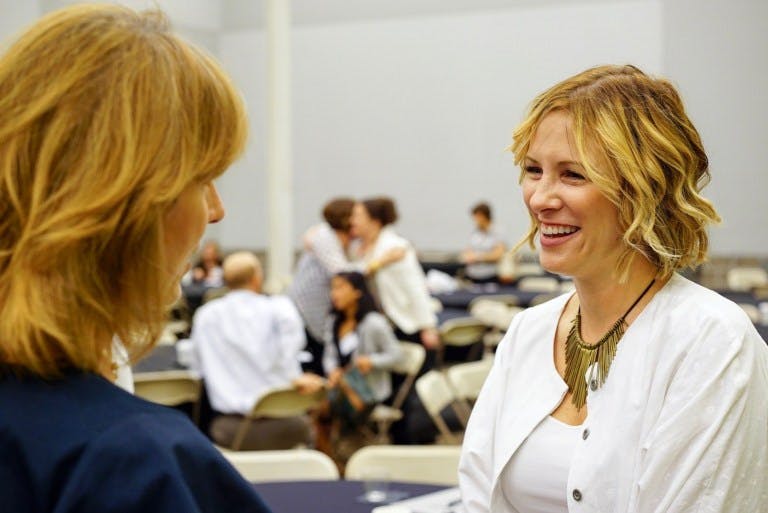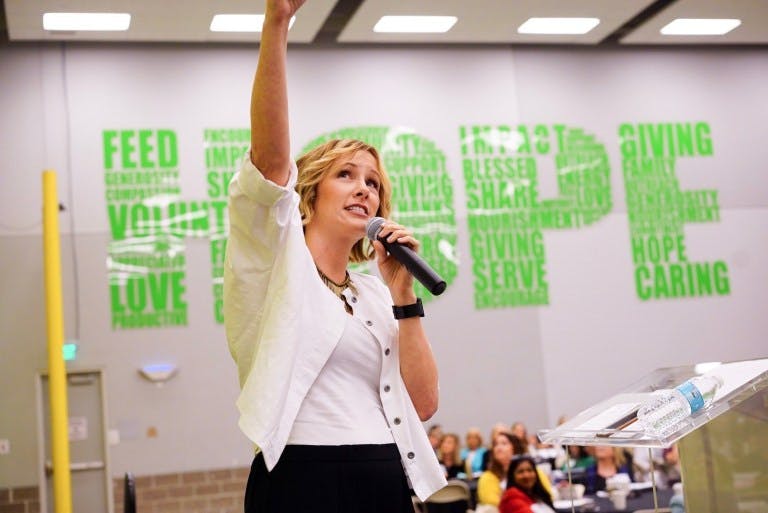The Lady Gaga Guide to Forming Emotional Connections
You know that feeling when you jump out of a building? Nope. I haven’t either. Sheep rarely jump off stuff—that’s why you see them up so high in the mountains, surefooted and attached to the ground at the hooves.
So while we don’t jump off things, we do like to leap forward. We like to stir up emotions. We like to take action. We like to accelerate impact by directing that action and that energy in the direction of progress. Which is why one of our patron saints is Lady Gaga.
Pusher of pop boundaries, wearer of dinner-based attire, probably voted most likely to win at card games, Gaga is a triple-threat times three which is nine. She is a nine threat. Singer, songwriter, actress, dancer, style icon, humanitarian, philanthropist, advocate and activist—dang. Our hands get tired just typing that list.
While the first five are impressive, the last four are what I talked about at the Association of Fundraising Professionals Ask The Experts Conference last Friday. Using Gaga’s overachieving as an example, I walked the crowd of development and nonprofit pros through the following five ways to form an emotional connection with your audience.
Drum roll:
- Spectacle is exciting, but it’s nothing without substance.
You can have a beautiful brand, a shiny new website, all the gorgeous collateral in the world, but if you can’t get across why people should care about your organization, they aren’t going to open their hearts to your mission. And if they don’t open their hearts to your mission, they definitely won’t open their wallets. There are organizations all over the world with fewer resources than yours that are making just as big of an impact, or sometimes even more of an impact, than you are. Why? They know exactly how to emotionally connect with their audiences through telling a substantial, inclusive, accessible story with flair.
Take, for example, the Ol Pejeta Conservancy in Kenya. They did something really unusual recently, something that made people do a double-take: They created a dating profile for a rhino.
- You are not your mission statement.
Finding out what you stand for means more than just reading a mission statement. You have to be unapologetically devoted to your core values. If your values start with honesty,…please, throw them out and dig deeper. While we do live in a time where dishonesty seems to be running rampant, honesty should be a given. What are you really about? I hope you’re honest, but aren’t you also interesting? Gaga is, by mission, a pop star. She sings, she dances, she jumps off stadiums. But she has core values, ones that are inclusive, unapologetically serving LGBTQ youth and those with mental health challenges. That’s her passion.
Your passion is what drives your story and, by virtue of this, drive your audience to connect with you. Sit down with your team—not just your executive leadership, but your programmatic staff, your front line folks—and talk about your mission. Take that mission one rung up and make it a North Star: Something that orients your team during their everyday tasks. Ask your people what drives them, compare it to your mission and see how aligned they are. If there’s a gap, fill it.
- Power to the People
You have to put the power in the hands of your audience. You have to give them ownership of your ideas so they can connect it to their beliefs. Self-expression is one of the most critical components of successful brands today. People care about things they can relate to and participate in—you have to make your story compelling and conversational—no one-way streets. Invite your audience in!
Once you rally internally around your core mission/north star, take a hard look at who you’re trying to reach. Name these people. Design personas for them. What do they like? Where do they live? What do they do for fun? Where do they work?
Then take your story and rewrite it for each of them, emphasizing the information they’ll care about the most. Tell them why your mission impacts their community, their industry, their lives. That is compelling. When we brush up against things that affect us, we sit up and take notice.
Sure, maybe people that share Gaga’s mission don’t strictly love danceable club pop music, but maybe they like the camaraderie that her Little Monsters share. And so they found a way to be part of her story and connect with it.
- Set. Activate.
Activate people by inviting them into your cause by giving them a piece of ownership. When an organization gives you a clear path to participation, people are more likely to take action. What is it that you want people to do? Don’t be so quick to say “DONATE!” I know we’re at an event dedicated to fundraising, but there are probably a few steps before that we need to consider.
Do you want people to visit your site? To connect on Facebook? Take those personas and draw a map of what actions lead them to you, what they need to do then they get there and what you hope they’ll do next. This will help you find ways to use your story to drive them to those ends.
A great example of a brand doing this is the Alzheimer’s Research U.K. which worked with Shazam to pull off a powerful stunt that resulted in almost 6,000 visits to its donation page in a 24-hour period.
- Give them a millionreasons.
You have a story, you have conviction, you have people you want to reach and actions to drive them toward. Now you need urgency. They need a reason to act now. Gaga, like Beyonce, is great at hype. “You NEED to see this, get this ticket, buy this album now because you’re going to miss out.” An event, an urgent crisis, a big opportunity with a deadline—these can be leveraged to drive real action when coupled with conviction. An obvious example of date-based urgency is Giving Tuesday. It’s a well-known day for people to reach into their wallets and donate to worthy causes, but the thing is—it’s saturated. The actual day is so noisy it’s difficult for organizations to break through. I personally think that every Tuesday should be Giving Tuesday. There is always an opportunity to create the same kind of urgency.
If by this point, you don’t have one of Gaga’s songs stuck in your head on repeat, then you are way stronger than I am. I realize that when we’re talking about nonprofits, a lot of times the subject matter is deeply important and very serious, and spending time talking about Little Monsters and meat dresses can seem a little goofy. But there are learning opportunities everywhere. In other organizations, in our communities and in our musical tastes. What works in another industry can be powerful fuel for what each of us can do to drive our missions forward.
I urge you to seek out different teachers in different industries. Like Gaga taught us today, you may find inspiration in the most unlikely of places.
-Aimee Woodall is our founder and CEO. She references Lady Gaga in the office at least once a week.
To hear all the flank puns you had to be there.
To see the presentation for yourself, you don’t. (Lucky duck!)
Check out the full presentation on Slideshare:

